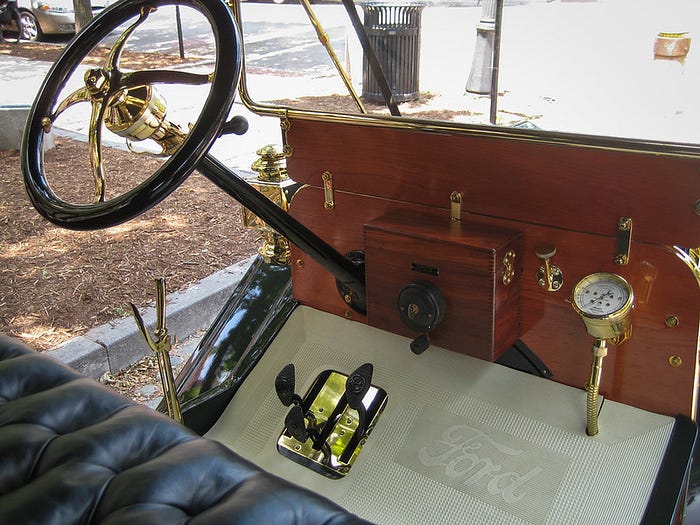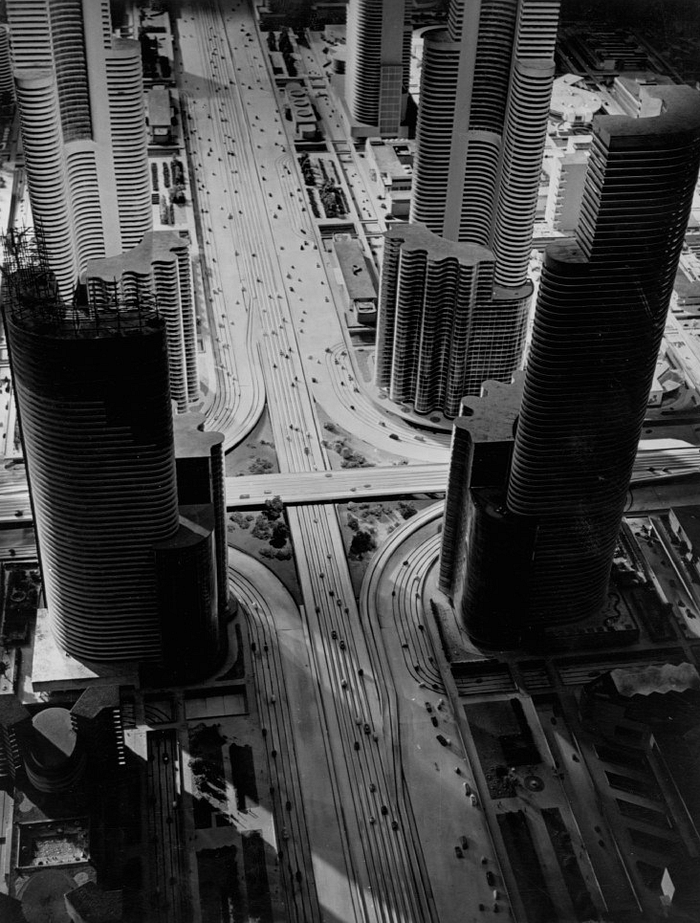The United States is without a doubt, the land of the car. Car Culture itself was born in the States. In most cities in the United States, it is impossible to live without owning a car. But it wasn’t always like this. At the turn of the 20th century, city life in the United States mirrored the cities of Western Europe. However, over the next few decades, society transformed into one that became entirely dependent on motor vehicles. This was not by accident. There was a serious effort by auto manufacturers to make people dependent on cars. Public manipulation, backdoor government deals, illegal business practices, and demolition of entire neighborhoods all contributed to the car-centric life we live today.
Cities in the United States used to have lively city centers and main streets. At the turn of the 20th century, the streets of many cities in North America were alive with every different type of transportation of the day. The streets were full of pedestrians, cyclists, horses, streetcars, and automobiles — the newest technology on the block. The scenes are a wild mess where there are no traffic rules. It is a beautiful symphony of ordered chaos.
However, soon enough it would just be chaos. In the early days of motoring, cars were — to put it mildly — death machines. They were unreliable, difficult to drive, and safety hadn’t been invented yet. Have a look at the original Ford Model T interior. It’s surprising that anyone made it through those early days alive. And with no traffic laws, nobody was free from the wrath of the cars. Automobile accidents became one of the leading causes of death — including death of children. And because of that, they started getting bad press. News stories were a dime a dozen about the newest deadly machines plaguing our cities. All the bad press was putting pressure on the auto industry. Bad publicity is bad for sales.

The Vehicle Offensive
To combat the bad PR, the auto industry decided to go on the offensive. The first step was to lobby governments to change laws and make large-scale investments in road infrastructure. They made sure to teach kids that the street was for cars — not people. They produced propaganda that painted people who walk in the street as adrenaline junkie lunatics. They lobbied governments to introduce jaywalking charges. Jaywalking was invented so that the cars didn’t need to worry about people in the street. They were given a designated area where they were allowed to cross. For thousands of years of humans living in cities, the streets were open for everyone, and suddenly walking in the street was illegal. After years of unruly murder and destruction in the streets, the city of Cincinnati proposed to make it mandatory for cars to have speed limiters. Before this, the only thing limiting the speed of cars were the people in the way. The auto industry lobbied against it by using some shady tactics. They likened those who supported speed limits to be anti-progress. They helped rally vehicle owners to vote against the proposition. The car lobby won and speed limits were not introduced.

By the end of the 1930’s, the car industry was well on its way to monopolizing the streets of American cities. They had been campaigning to get all other forms of transit out of the way to clear the streets for cars. And what they did next all but cemented America as the land of the car.
In the early 20th century, many American cities had streetcar networks. These were comprehensive public transit systems that served all of the people. There were even suburbs built around streetcar stops for people who didn’t want to live in the busier downtown. These streetcar suburbs had houses in walkable distances to stops that picked up commuters. It’s hard to believe now, but nearly 100 years ago, American cities had public transit systems that were miles ahead of what there is even today. The auto industry saw this as unacceptable. As far as they were concerned, these transit systems were taking away potential customers — they must be stopped. First, they lobbied governments to allow vehicle traffic in the streetcar lanes. This gave vehicles more space in the city while slowing down public transit. Two of the major factors for a successful public transit system are speed and reliability. Slowing down transit makes it a less desirable mode. After that, ridership fell, revenue fell, and eventually the streetcar networks operated at a net loss for the city. The streetcar operators companies were failing, and the automobile industry knew this and decided to go in for the kill. They set up shell companies and bought up the streetcar companies. They limited services even further and eventually the rails were ripped out. The streetcar era was over.
At the 1939 World’s Fair in New York City, an exhibit was featured as a vision of the future city. “Futurama” — as it was dubbed — was designed by Norman Bel Geddes. The exhibit displayed what many people in the United States and Canada would recognize as a big city. Tall skyscrapers in the downtown, lined by highways going out to the suburbs where the people lived. The highways are all high capacity and nearly empty. This vision of the future was also sponsored by General Motors. An automobile company presenting their idea of the future to the masses. And the masses were smitten. This presentation of 1960’s America was seen as the prosperous future where everyone would drive from the suburbs to the city for work, and drive home again in the evening. By the start of World War 2, America was well on its way to becoming a car country.

Futurama Made Real
After World War Two, President Eisenhower started the interstate project. He was keen on creating a network of high speed connections across the country to ease troop movement and connect the country for commerce. He appointed the Chief Executive from General Motors — Charles Wilson — as the Secretary of Defence and plans were drawn up to connect cities. The plans included constructing highways running through downtown cores — not unlike Futurama. Whole neighborhoods — typically ones with high racial minority populations — were demolished to construct the highways. Those who could began to move out of the cities and into the ever growing suburbs — not to mention racist policies like “redlining” that effectively segregated nearly every city in America and drove white flight out of cities. Redlining is a topic worthy of it’s own series. Just as Futurama showed, people would drive in to the city every morning for work, and drive home every evening. And because all of those cars need to be put somewhere, buildings were demolished to construct parking lots. And to get those cars in and out as fast as possible, buildings were demolished to make way for highways. All of them demolished in the name of progress. Demolished for rich and affluent. Demolished for cars.
American cities weren’t built for the car. They were demolished for the car.
The darkest times for American cities ensued. The more affluent people moved out of city-centers and into the suburbs. Their tax dollars went with them. Soon, the suburbs not only had the newest and biggest homes, they also had the newest schools, hospitals, and retail malls. A drop in tax revenue meant there was less money for the city to spend on inner city services like schools and public transit. These systems degraded and the cycle of divestment was soon out of control. The economic exodus was followed by a rise in crime. It reached a point where phrases like “Inner City” or “Urban” were synonymous with high crime. The downtown areas of many cities quickly became a place where you only went if you absolutely needed to. These neighbourhoods were demolished to build highways to get suburbanites out as fast as possible.

At this time, the rules of city planning and architecture began to change to account for people’s new lifestyles. Everything was built to accompany the car and it was assumed that everyone would drive everywhere. Streets were built wider. Parking minimums were introduced. Land uses were separated. Even the style of architecture became car-friendly. Buildings now have minimal features and have become monotonous. I contend that it is because nobody will ever be walking passed these buildings — and therefore won’t notice how ugly they are. In suburban developments, the parking requirements have resulted in parking lots that are larger than the buildings they serve. Massive oceans of concrete and asphalt parking lots are extremely wasteful, harmful to the environment and all but guarantees that these places are not walkable.
Now, more than 60 years into the Furturama experiment, the idealistic picture of this type of urban design is showing it’s uglier sides. Analyses of the economic viability of this model show time and again that they are not sustainable in the long term. The costs to maintain utilities and roads to serve the homes cannot be made up in property taxes collected in suburban areas. When taking the land area into account, downtown developments pay more than their fair share for the services they receive. Effectively, it is the “poor urban” neighborhoods that support the “affluent suburbs” to collect their garbage, repair their roads, and treat their wastewater.
The Turn Around
Despite all of this, things are starting to turn around. Cars are no longer given automatic priority when it comes to new urban projects. More and more projects are reclaiming the streets for people. Extending sidewalks, installing bike lanes, installing traffic calming measures, reserving lanes for public transportation. During the pandemic lockdown, many cities put in temporary patios for outdoor dining that extended into the streets and restricted traffic flow. These became so popular that many of these cities have made these changes permanent. People are beginning to realize the value of being able to enjoy their city. And city planners and councillors are seeing the benefits of creating spaces for people — not cars. Despite these improvements, there is still a very long way to go.
Younger generations are also finding it difficult to buy a home in the suburbs. In recent years, the housing market as priced many young people out of home ownership. This has shifted their priorities to prefer living in areas that are well connected to the rest of the city and in walkable neighborhoods. This also opens up the possibility of living car-free — driving up demand for good public transportation and connectivity. Hopefully this change will continue to drive improvements to public transportation and cycling networks.
The popular story that American cities were built for cars is only half true. Most major cities in the United States were built before cars became popular. Through a significant effort from the auto industry and some shady business practices, many of these cities were largely demolished for cars. After the 1950’s it was taken for granted that all travel would be done in a car, and the land use development patterns reflected that. These mistakes are starting to be realized and changed. There is a long way still to go, but the seeds of change have been planted. It’s now time to cultivate that change and use it to create better places for everyone. It’s time we rebuild our cities not for cars, but for people.
